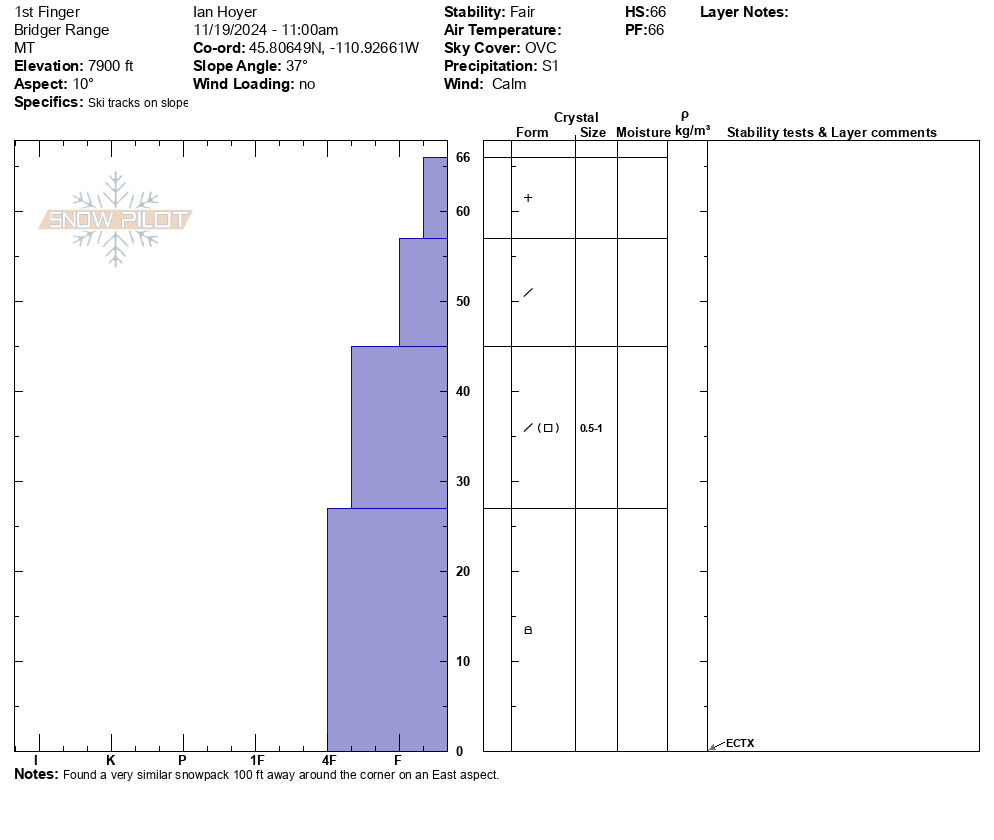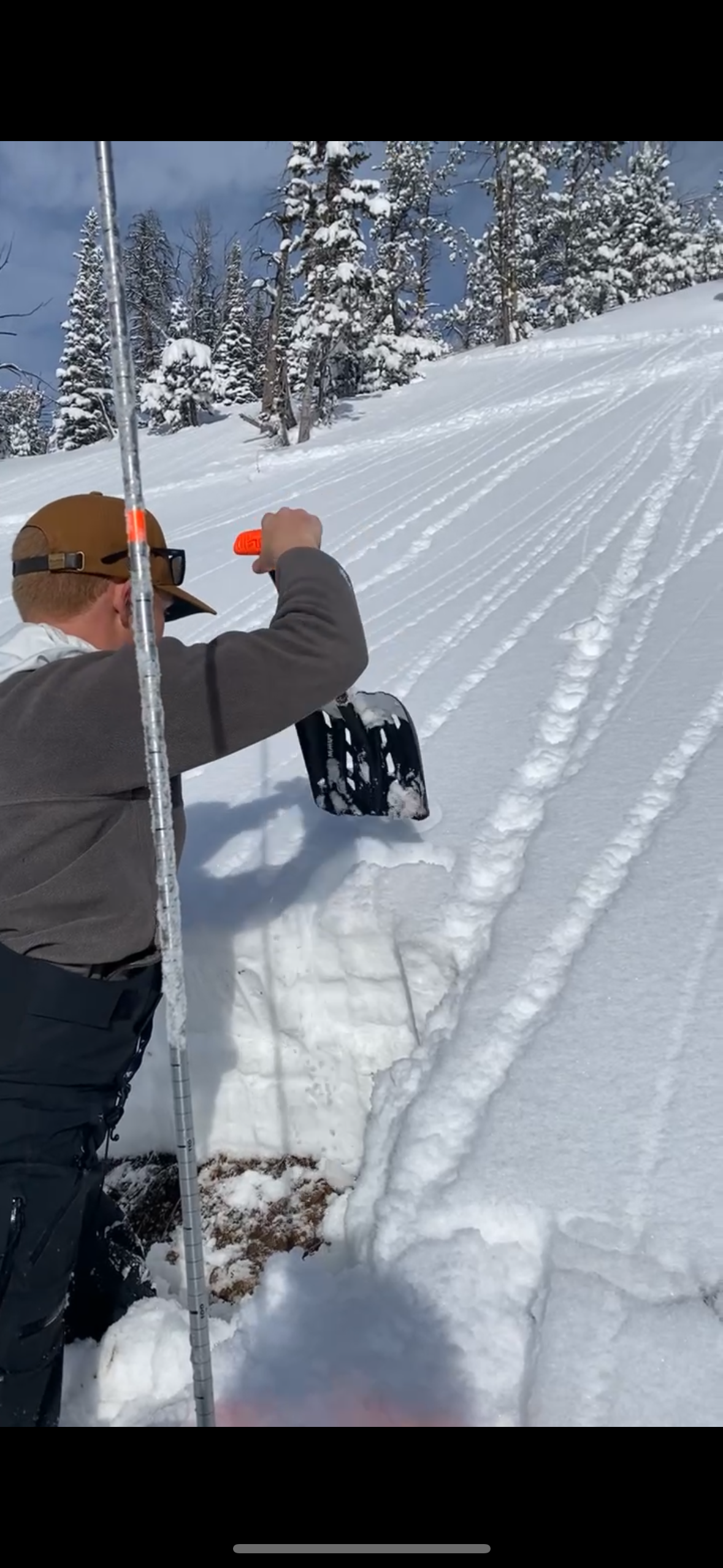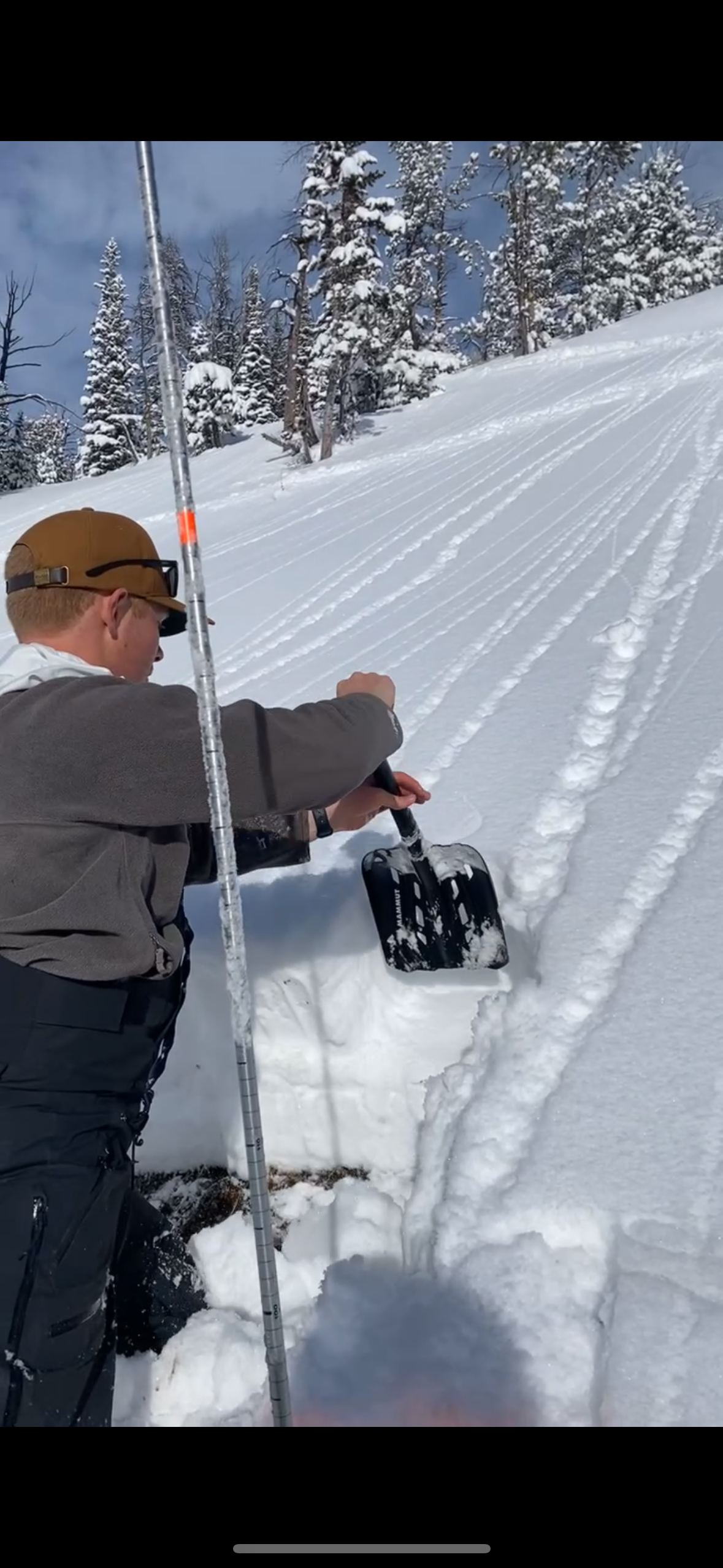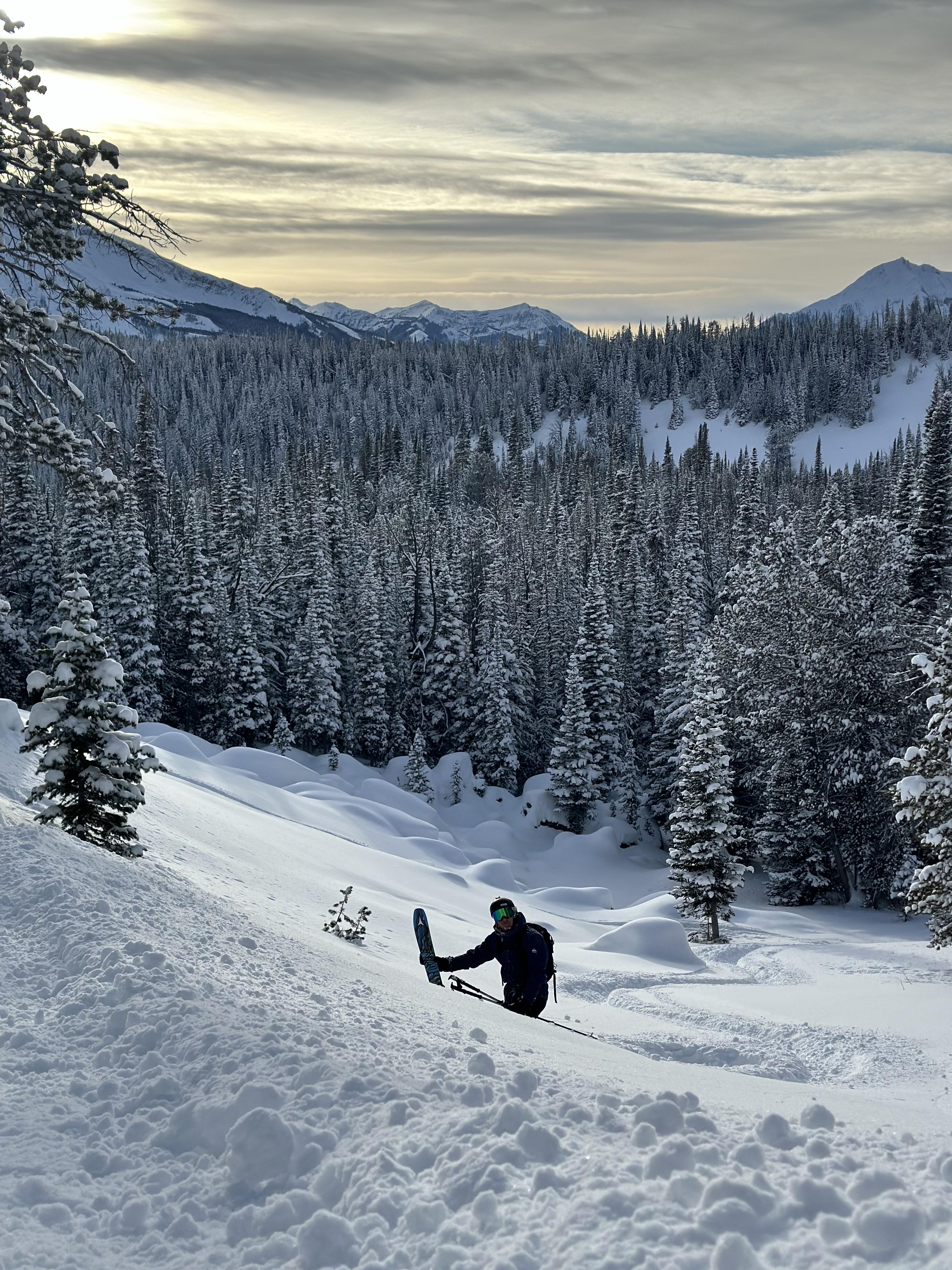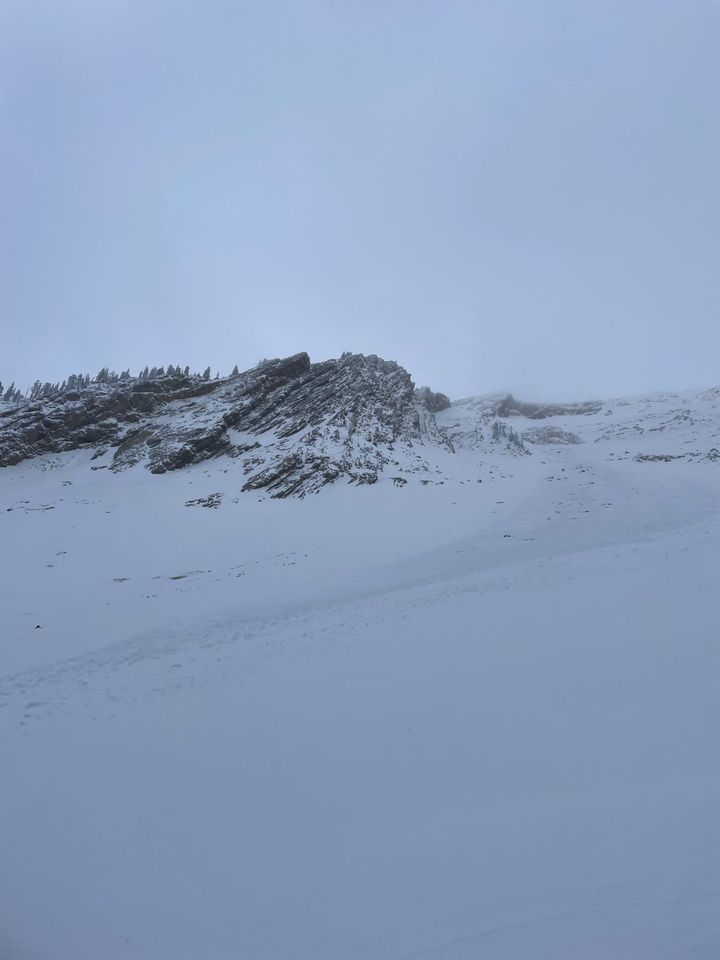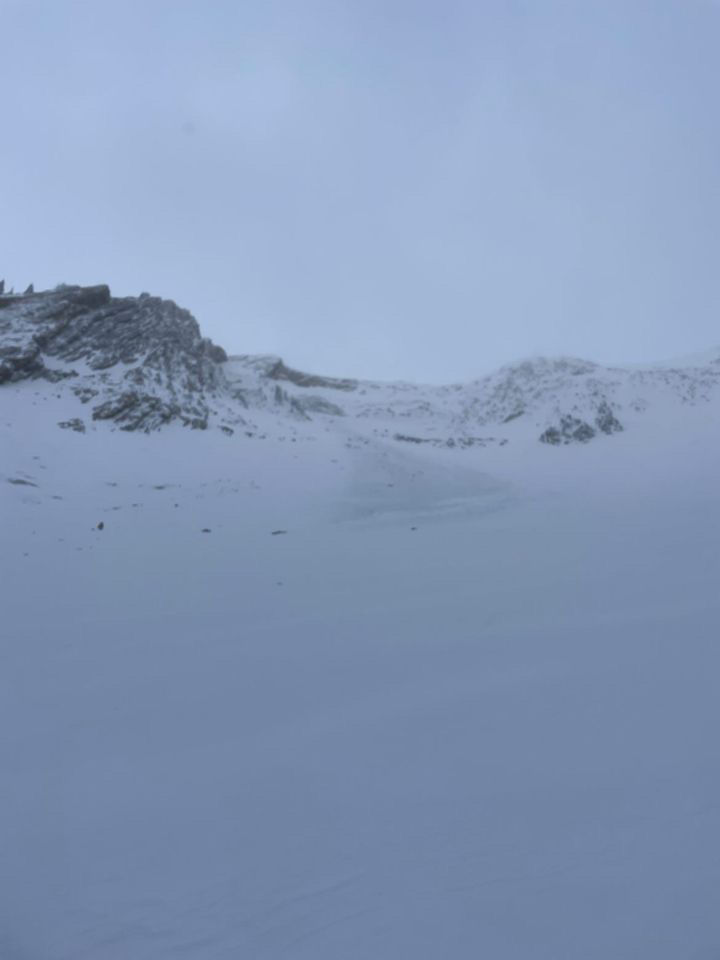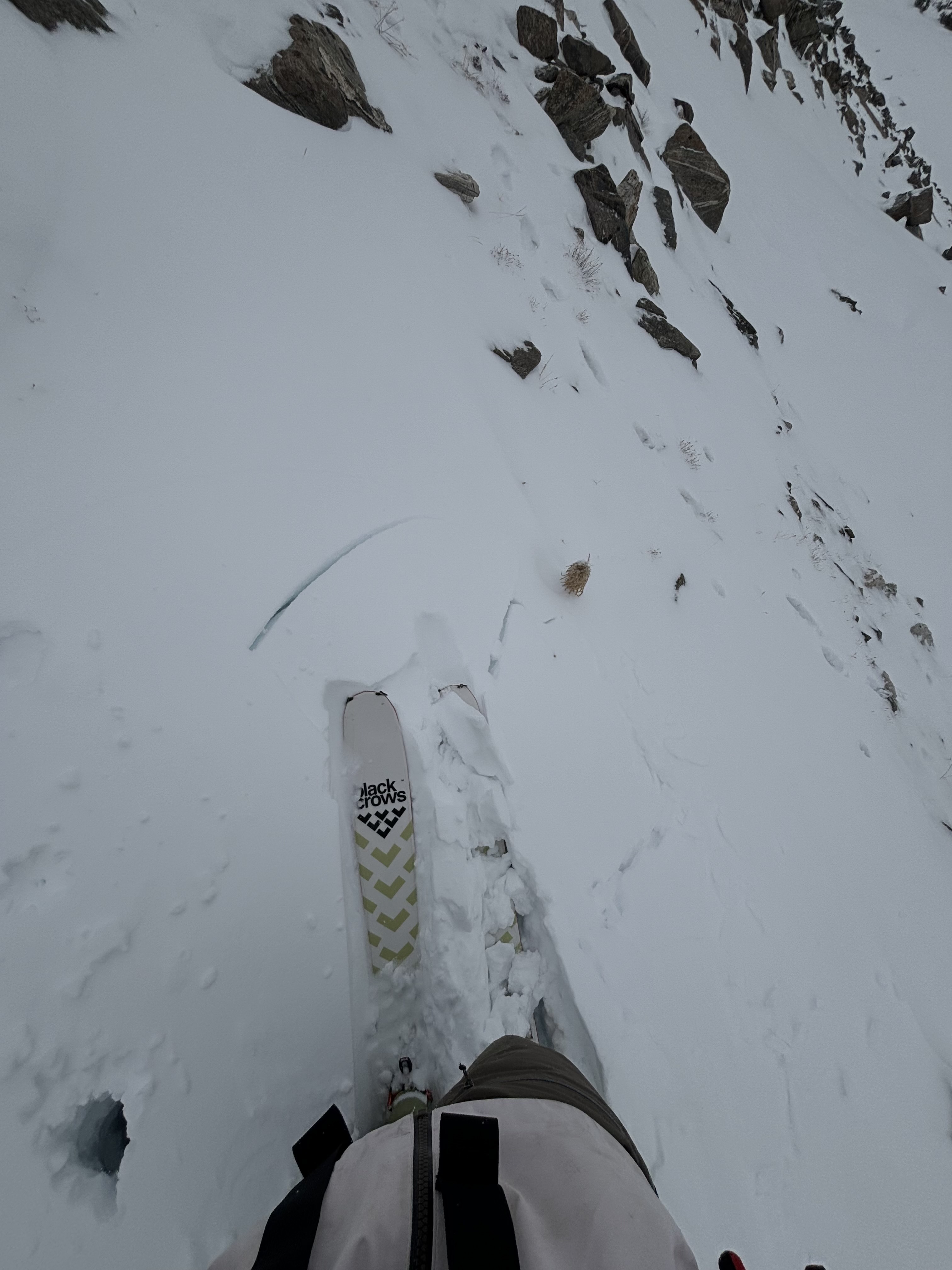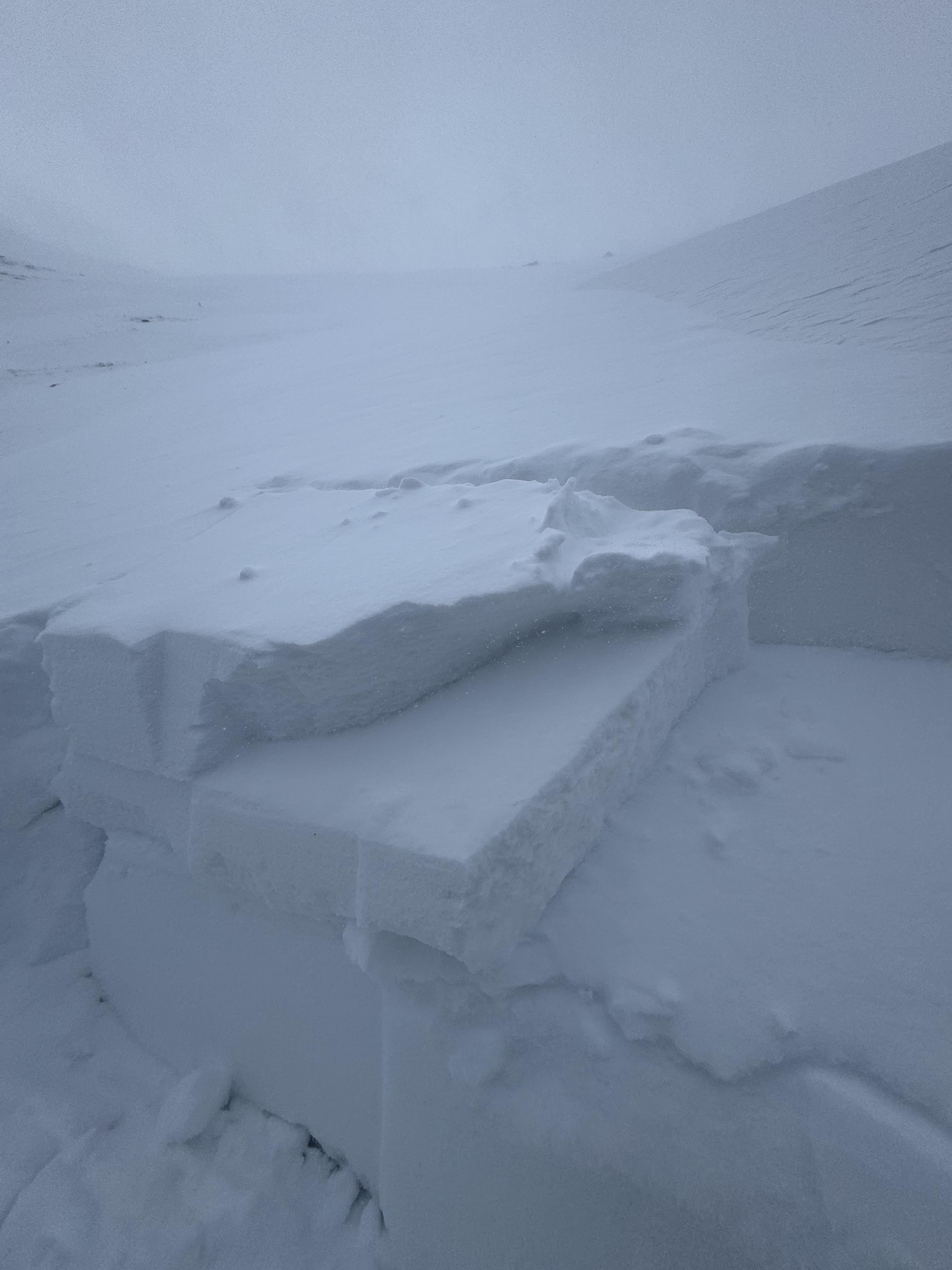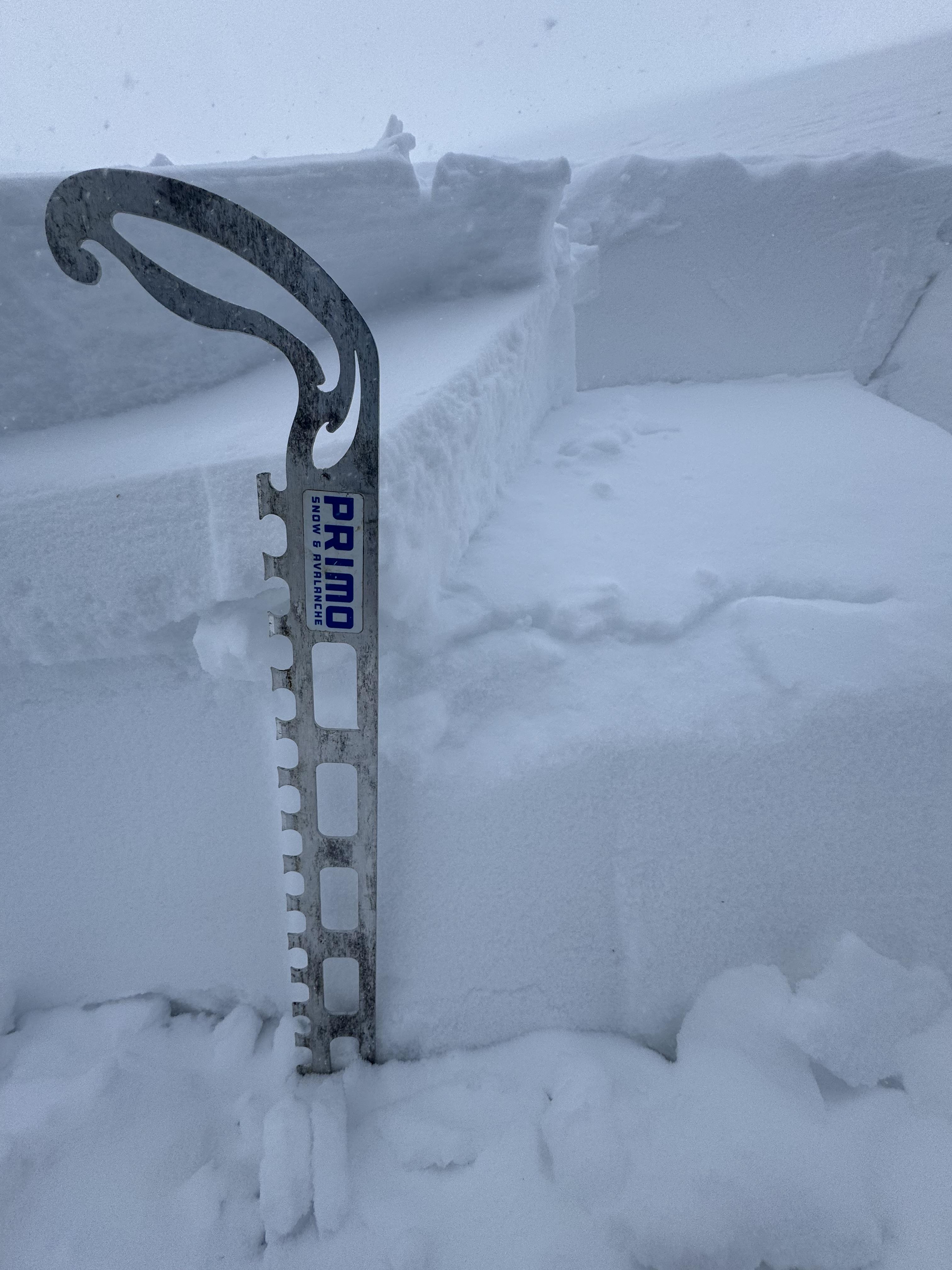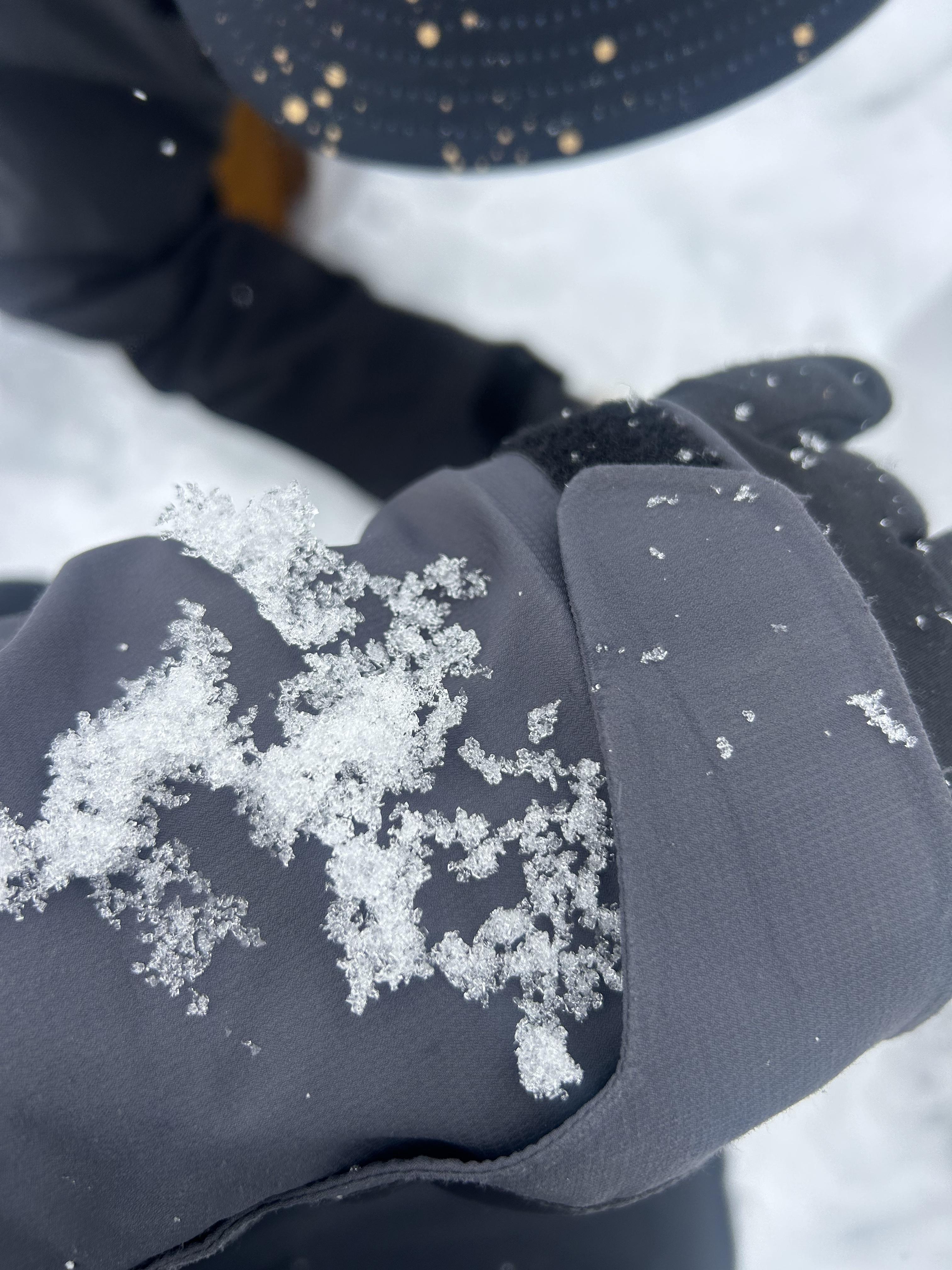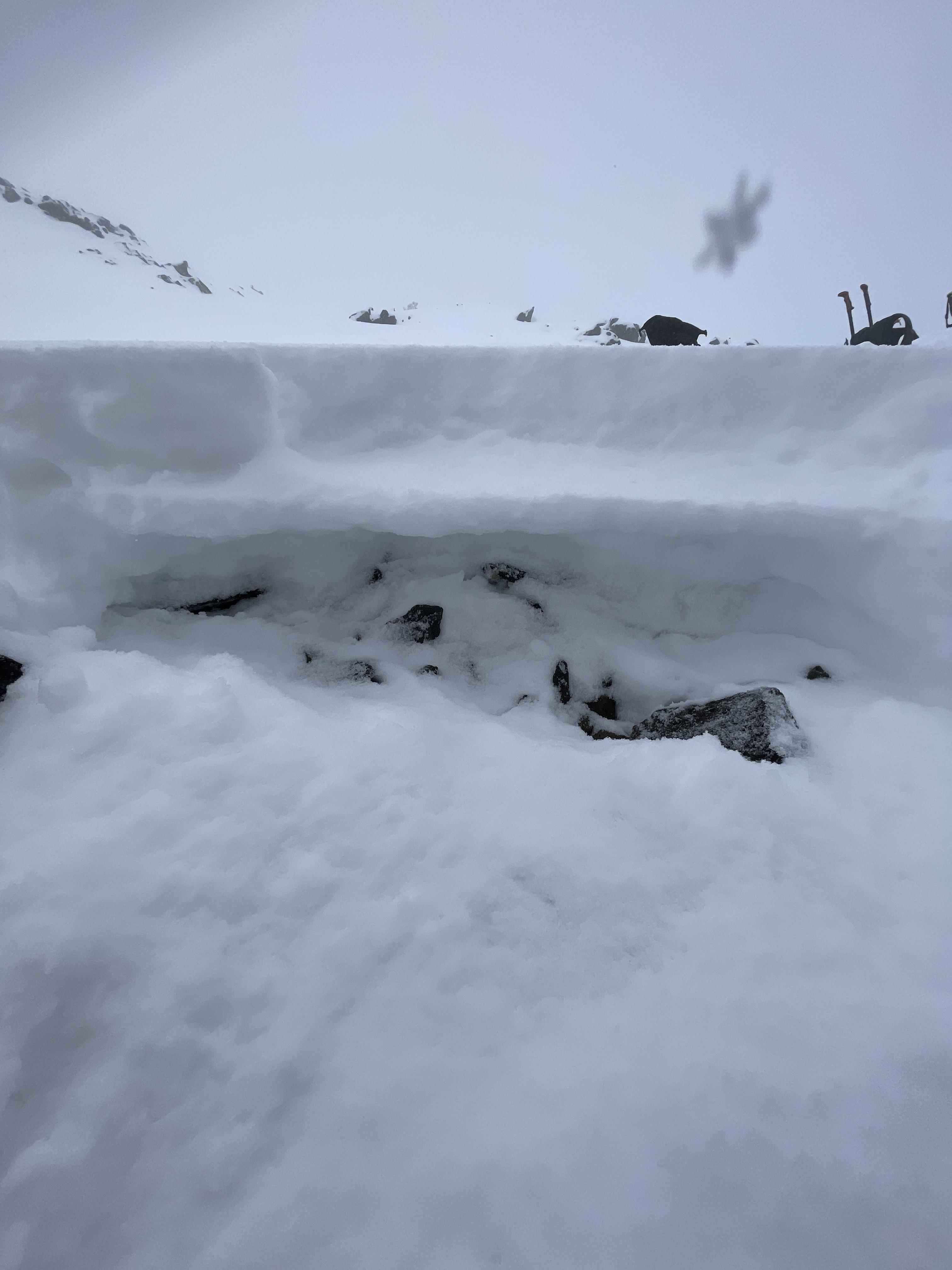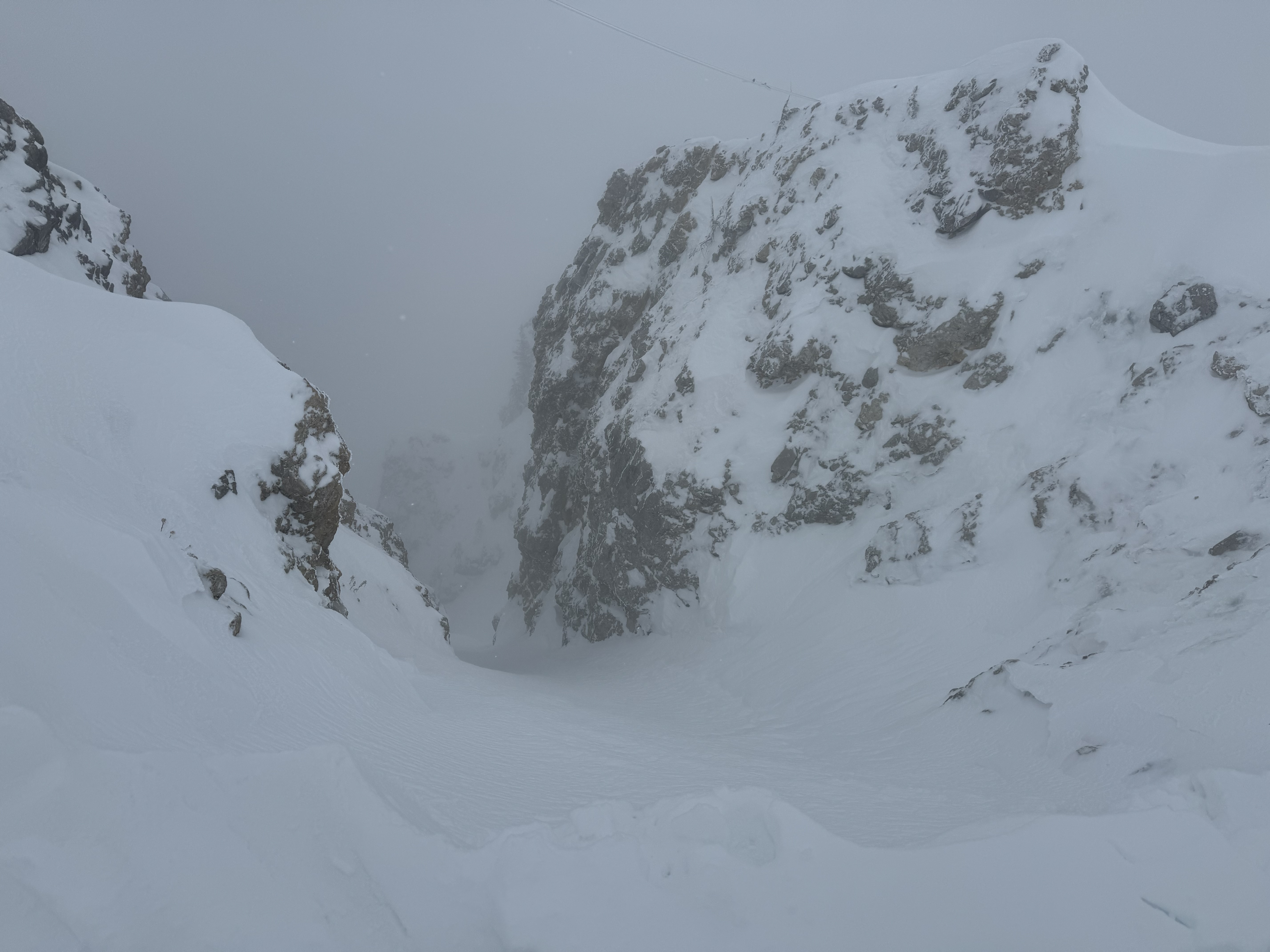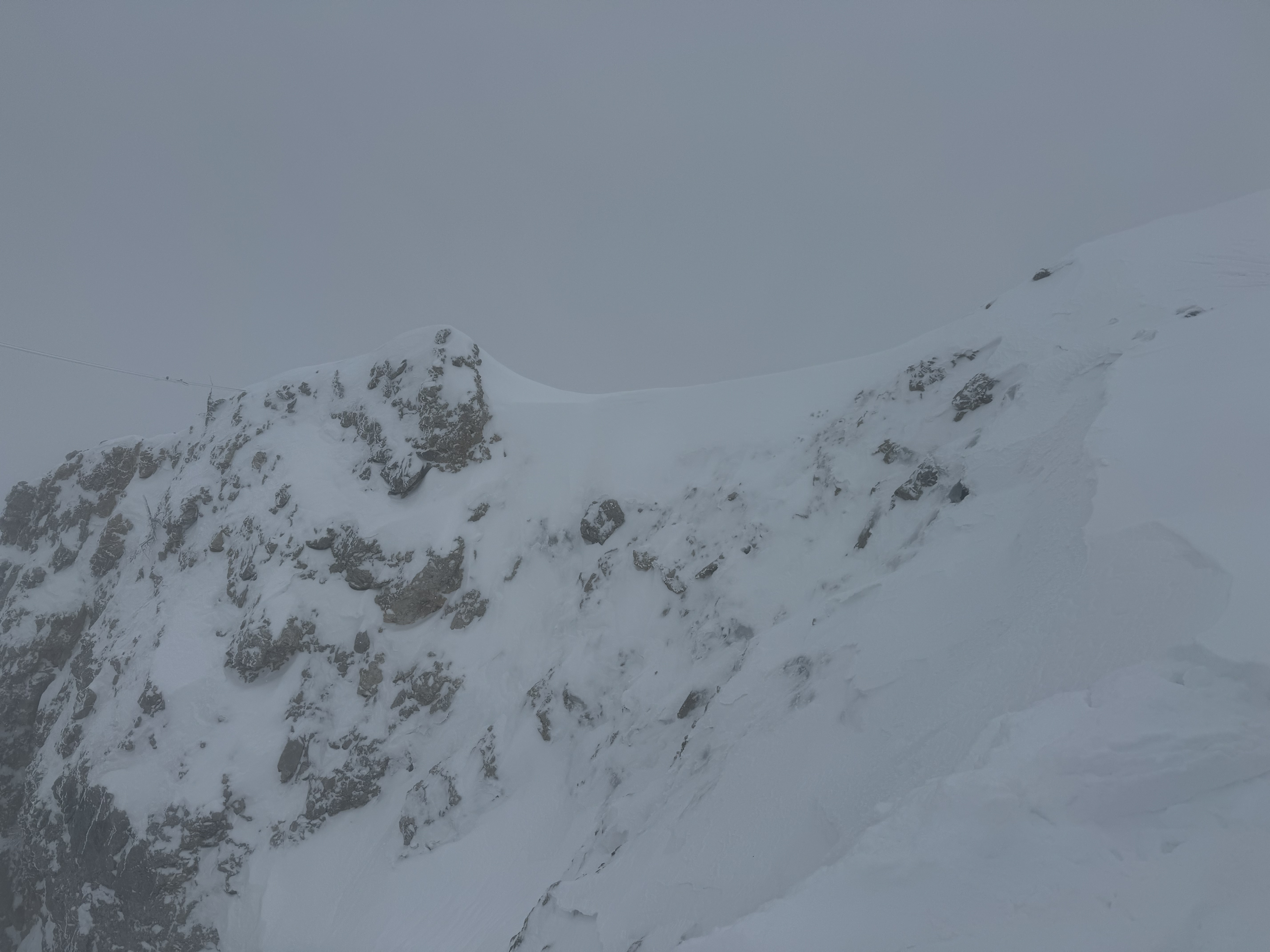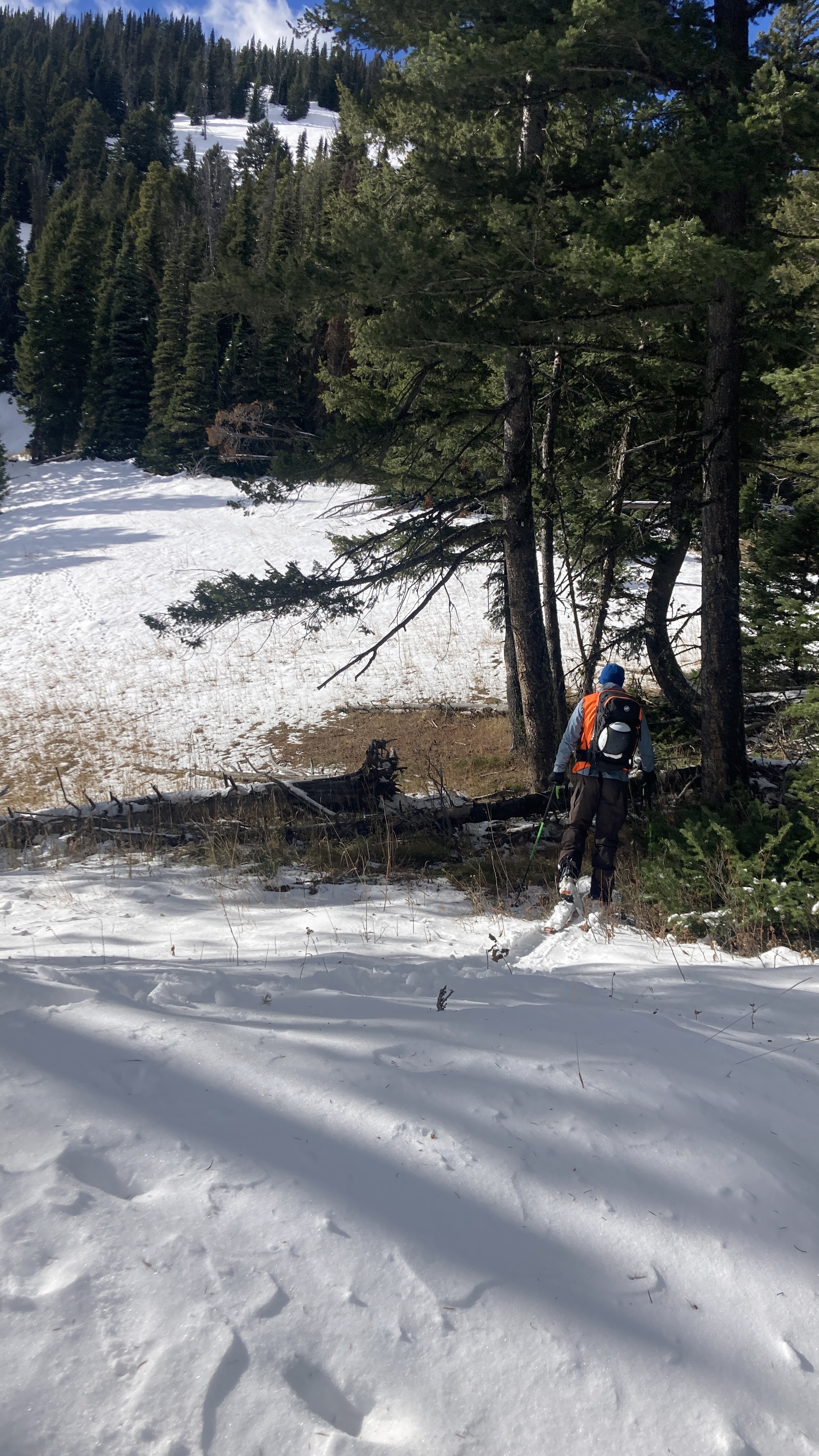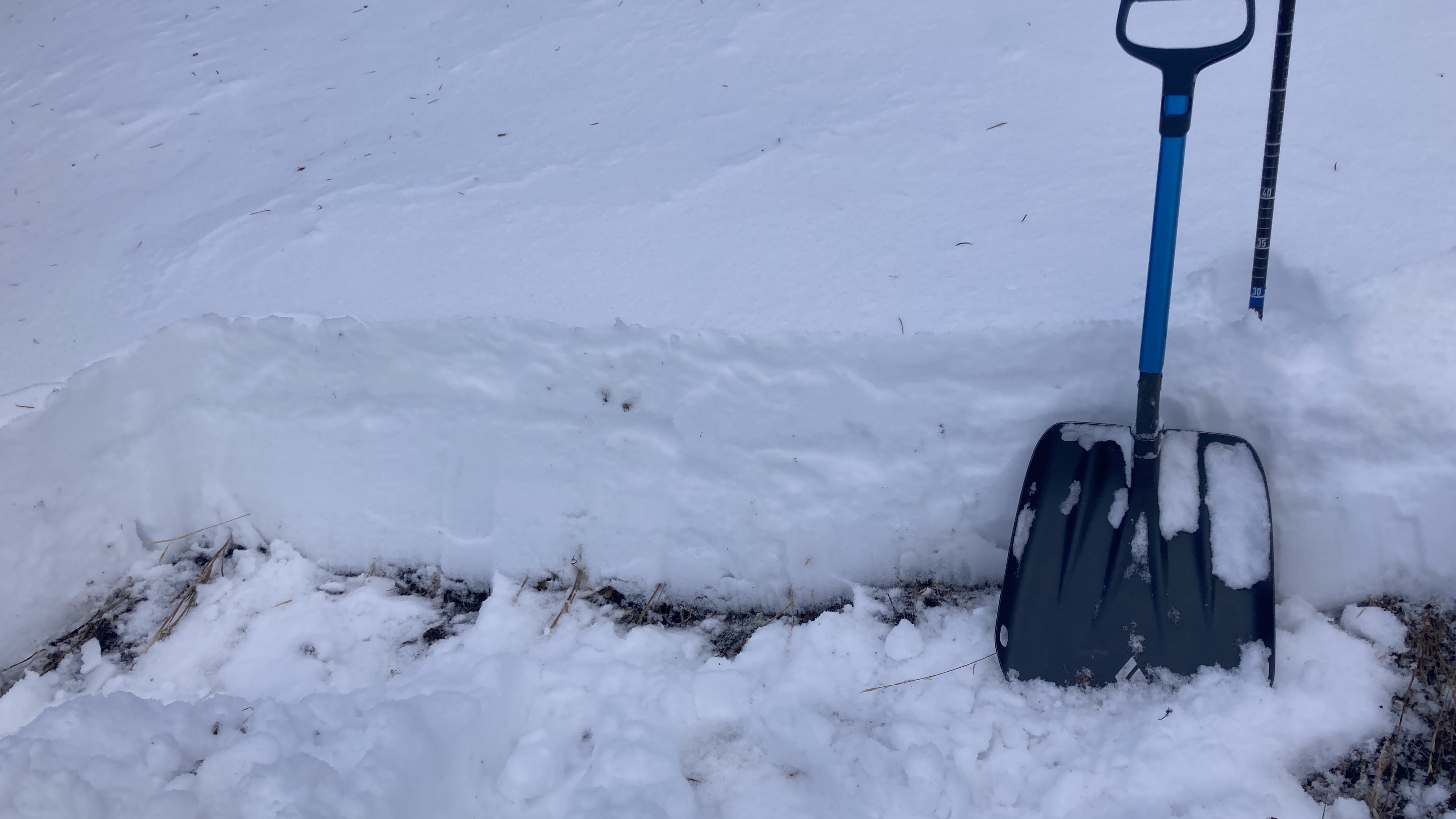Snow Observations List
Skinned up to the top of the Pierre's Knob lift and then up the Finger's Meadow, poking into top of the 1st Finger. Total snow depth was around a foot, or a little less, in the base area. Near our high point at ~7900ft, snow depths were around 18" to two feet. A snowpit on a north aspect in the top of the 1st Finger showed a "right-side-up" snowpack, with the softest snow at the surface, getting progressively harder are you go down. ECTX. A little bit of faceting was visible in the older snow, but it hadn't done much weakening. A quick hand pit on an east aspect in the Finger's Meadow showed a similar snowpack structure. Plenty of snow to trigger a slide, but still a very thin snowpack with buried rocks remaining a huge hazard.
No avalanches or other signs of instability observed. Snowed lightly but consistently all morning, with an additional inch accumulating by the time we returned to the car.
Full Snow Observation ReportStill early, but the base is looking good, for now. We'll see where it goes.
Lots of folks out and about at Bridger.
Toured up to Blackmore NE Ridge, about 200 feet from the summit Tuesday. Mix of sun and clouds. very cold, light to no winds. fresh blown snow was over 1' deep up high and felt very stable. We did not notice any wind slabs though it had been windy overnight, the N.W face of elephant was completely scoured almost down to rock. Some small cornices forming on the ridge with the slightest wind skin in some places. snowpack was around 3' deep on the lee (E) side.
Full Snow Observation ReportTwo obvious layers. sun crust layer with a foot of wind blown on top. top layer failed while isolating column for pit test. photos are from a video that i cannot attach. it just shows the two layers. i tried to preform the test to the left but it failed prior to any taps.
Full Snow Observation ReportFrom IG: “(Photos) From a slide on the south side of October bowl today“
Full Snow Observation ReportDug a snow pit on a northern aspect at Bridger Bowl around 7800ft of elevation. Snow depth ranged from 45-50cm. Had a very reactive CT 2 on the most recent snow layer around 25cm deep in the snow measured from the ground up. Attempted a hasty ECT before we lost sunlight but did not get propagation. There was visible wind loading on upper elevations as well.
Full Snow Observation ReportI skied all three meadows at History Rock this morning. The recent storms have done good things, and there is no longer a mix of snow and dirt, but around 3-9 inches of new snow in Hyalite. Winds were surprisingly light, mostly of of the south, and snowfall fluctuated between light and moderate, with a total of 2-3 inches of new snow on my car after several hours of skiing (it was good). The new snow didn't seem to be bonding great to the underlying crust, but I saw no bullseye signs of instability.
Full Snow Observation ReportParty of three made our way into Beehive Basin up to near the bottom of 4th of July Couloir. Noted strong winds blowing from the south southwest (up the canyon) Saw shooting cracks up to 8 feet out skinning up a boulder pile on a east facing aspect, (picture my friend took). Snowpack still to shallow to confidently ski any of the upper couloirs. Further down in the canyon on the short grassier slopes snowpack was reasonably dense and stable with a weak crust layer under 8-10 inches of the light fluffy stuff, snow depth up to 2 feet in select spots. Friend reported hearing one small whumph breaking trail up to the ridge on a convex roll. Skied out the entire slope with 10ish other people and didn't see any other signs of instability.
Full Snow Observation ReportFrom obs: "I’ve been skiing the Erma Road recently. Good conditions for a quick ski up the road by but it’s thin off the road. The 616 trail is too treacherous for my comfort zone. I think the Republic Creek alpine valley must be skiable though. Quick observation:a sun crust formed in the open areas on the road and on adjacent areas."
Full Snow Observation Report
Winds were relentless! Enough to quickly fill bootpack of partners no more than 50 ft in front of me, clear signs of loading.
Snow ranged from a dusting over rocks to some consistent 30-55 cm ribbons of deeper drifted veins of snow. Deepest pocket found was around 65/70cm.
Main recipe found was a growing stout wind slab on top of an older wind slab above some earlier season snow that was barely starting to facet at the base. No propagation on ECT but could change as the weight builds, very obvious slab development.
Ride slow and safe as rocks and thin snow are the greatest hazards present, plus the brutal winds.
You CAN drive to the fairy lake parking, but 4x4 and great tires are mandatory. Remember to park with sufficient space for vehicles to pass up and/or down the road.
Full Snow Observation ReportWe skinned around hyalite basin today following the snowfall from last night. In the Basin, we found new snow varying from 8-12 inches. As visibility pushed us away from Hyalite peak, we skinned east towards overlook and dug a pit on a W/SW slope at 9100 feet. We found roughly 80cm snow with a small crust layer at 50cm as well as facets forming on the ground. While we had no propagation in our ECT, the facets forming will be something to watch over the next week with cold temps. No natural avy activity observed with the minimal visibility in the area other than some new snow sluffs on steeper terrain below ridge lines.
Full Snow Observation ReportMy partner and I climbed Twin Falls in Hyalite (it's fat). Snowfall ended mid-morning and I estimated 4-5" of new at the base of the climb (~7,500'). The wind was not blowing and there was 12-18" on the ground. The new snow bonded well to the old snow and I did not see any facets or depth hoar forming in the old snow.
There were lots of skiers heading up the Grotto Falls trail and Mt. Blackmore, so hopefully you'll get more info from them.
Full Snow Observation ReportToured through divide basin to divide peak this morning. Snow in the basin around 130cm based on ski pole penetration however the peak itself only had about 35cm where we dug a pit on a SW slope. The new snow was sitting on a sun crust about an inch thick that was very hard to break and took a solid punch with my fist to break. Underneath the crust was all sugary facets sitting on rock. Semi-Poor skiing
Full Snow Observation ReportWe found 3-4 inches of new snow while touring up Bridger and accessing the ridge via patrol chute. The new snow was on a hard crust to the ground that had not bonded yet and we observed some cracking in isolated wind affected regions. The East wind on the ridge last night formed cornices in unusual spots up high, and there was minimal cornice growth on the Eastern (normal) edge of the ridge. We skied hidden gully that had small storm slabs that propagated at our ski tips and only ~3inches in depth. The snow within Hidden was not wind affected and actually made for some great skiing further down in the couloir!
Full Snow Observation ReportMyself and three others toured up to 8260 ft on the Ramp this morning. Down low on Alpine wind gusts from the W were strong but as we ascended winds diminished and I didn't notice wind effect or slab formation on the snow on the Ramp up to where we turned around. Temps were in the 20s and visibility was minimal from the Ramp with a Bridger Bowl cloud hanging over us. The snow depth on the Ramp was about 50 cm deep from the top of Bradley's to 8260 ft. Snow depths varied at the top of Bradley's ranging from more scoured areas (30 cm) to previously wind drifted areas up to 85 cm. The new snow surface from the naked eye looked to be a mix of wind broken particles and rimed stellars. Early season hazards still abound but the skiing was surprisingly very pleasant!
Full Snow Observation ReportEncountered a 6-8" old, unreactive windslab in Comet Alley yesterday. NE Aspect, ~8300'. Couldn't find a weak layer beneath it. Overall, the snowpack felt fairly homogenous on this aspect in this area.
Full Snow Observation ReportFrom obs: "Toured into a north facing chute at around 9800 ft. Found a thick stubborn wind slab near the ridge that was difficult to trigger and did not really move a whole lot. In the middle of the chute I found a 6 in thick softer wind slab. There was a lot of variability in the snow throughout the upper elevations, and signs of active top and cross loading with gusty, swirling winds."
Full Snow Observation ReportI went for a quick lap up PK today. Considering my car said 7 degrees Celsius in the parking lot, I was surprised by how soon I ran into dry surface snow on my way up. In sheltered areas approx 7000ft and higher I found 5-10 cm dry snow on a mostly supportive crust on N through E aspects. I didn't closely observe other aspects. At mid-elevations (~7300-7700) winds were moderate with moderate snow transport. Above and below this I experienced light winds and saw evidence of previous wind transport. I travelled to just above PK (~7950).
Dug a quick pit on a NE asp around 7800 ft, and found a mostly right-side-up snowpack with an HS of 40cm. Skiing was enjoyable, if not a bit anxiety-inducing when I ventured off the main runs.
Full Snow Observation ReportIan and I drove up the Langhor Road in Hyalite Canyon in order to access the upper meadows of History Rock. We wrapped around and intersected with the trail in the mid-elevation meadows. Snow depths varied from 0" to 18." We toured into the middle of the three ski meadows before stopping to assess how the season's thin snowpack is evolving. The snowpack has a relatively simple, three layer structure. The lowest layer is beginning to show signs of weakening (faceting). However, the foundation of the snowpack was looking pretty good for now. ECTX. While we are optimistic for now, the snowpack is thin and can change quickly this time of year. There was evidence of wind in the History Rock area, this has likely built wind-slabs at higher elevations and more open terrain.
The critical piece of information is that at mid to upper elevations the ground is mostly covered and we have a layered snowpack. We will stay tuned to how the snowpack evolves and how well subsequent storms bond to what we have on the ground.
Full Snow Observation ReportToured up into the Blackmore/Elephant basin today to get a sense of the snowpack ahead of the upcoming storm cycle. I poked around and dug in a few spots, trying to observe variations in snow depth and to observe where the snow has been faceting. Every pit I dug, ranging from N to SE facing, had faceting near the ground, all of which reacted in stability tests, if stubbornly. The most interesting test result was an ECTP21 in this layer of basal facets. That pit was dug in a large wind drift. I saw no propagation in any other pit or test.
Strong wind gusts were moving large amounts of snow in the alpine, while below treeline they did not exceed moderate speeds and wind transport was non existent. Large drifts were present on lee slopes, while more exposed windward slopes had little to no snow.
Otherwise the snowpack has behaved as one would expect. Solar aspects and exposed flats have a 2-3cm thick sun crust on the surface, and a further complex of crusts throughout the shallow snow pack. Snow depth ranged from 0 - 100 cm throughout the basin, and was generally thinner on solar aspects. Pretty bad skiing all around, not excluding the rock gardens on the skinner out.
Full Snow Observation ReportDug a small pit on NW aspect at about 9100 and saw about 5cm of faceting right on the dirt and got ECTP22 on that layer. Some surface hoar present but mostly melted off.
Full Snow Observation Report
